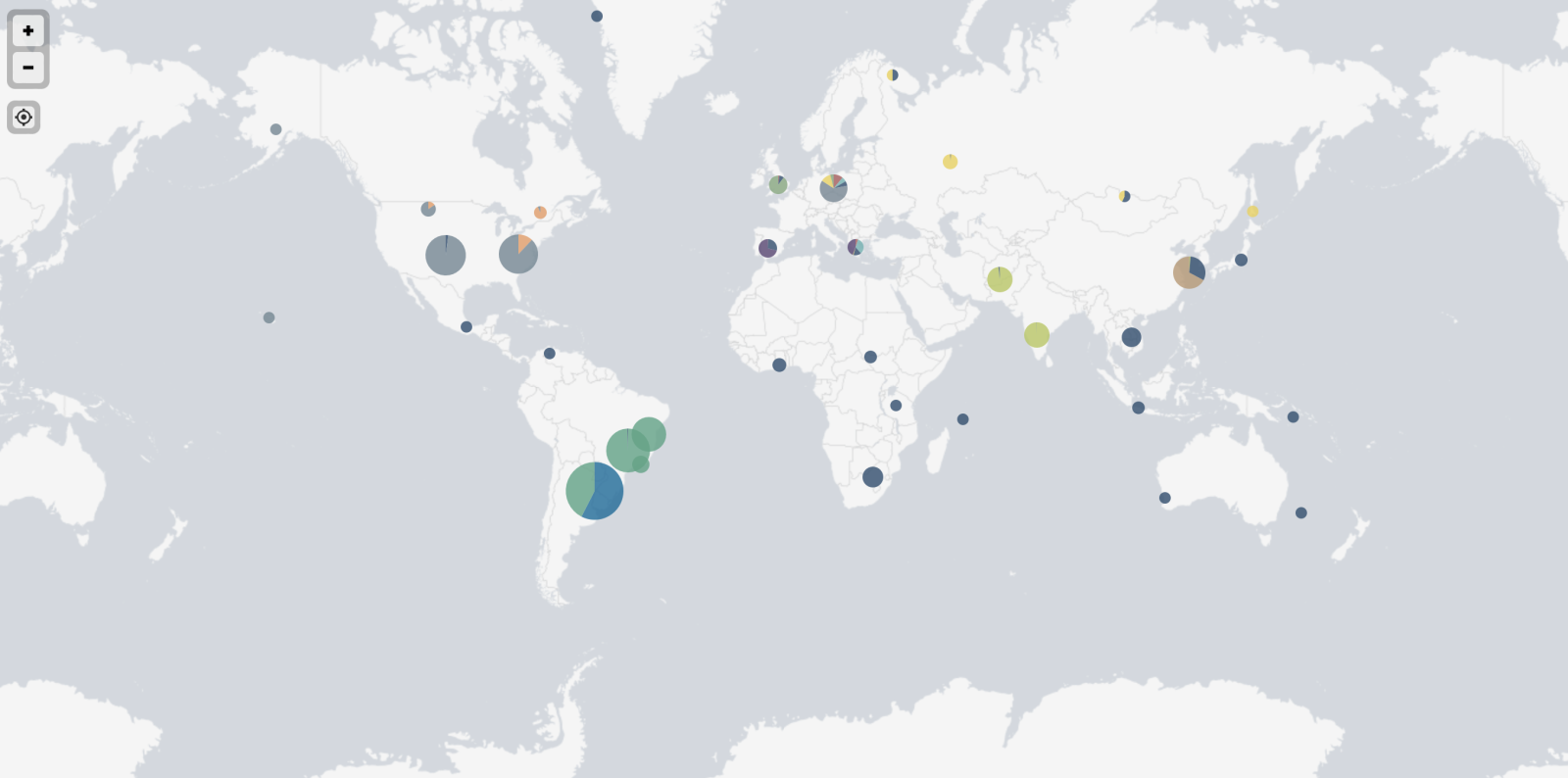Who Are Those Bots?
I’m operating a mail server for multiple domains. This server is regularly targeted by bots that launch brute-force attacks to try to steal credentials. They try a list of common usernames but they also try targeted ones based on a list of email addresses that have been crawled. The mail server is protected by several security controls. One of them is an automatic blocking of offending IP addresses to slow down such kinds of attacks (brute-force) but I noticed that this technique was less and less relevant. Indeed, when a new wave of connections is launched, they are coming from a lot of different IP addresses that just test a few credentials and, therefore, do not trigger the automatic blocking. I extracted the list of IP addresses that generated authentication failures for the last 30 days and got a list of 11K addresses. They are part of botnets used to launch these attacks. But who are those bots? What kind of host are we facing?
I performed a scan of the 11K IP addresses and tried to extract some useful information about them.
First, there are spread all over the world:

Top-20 of source countries:
Numbers Country
1964 Brazil
1439 United States
839 India
596 Argentina
457 South Korea
308 South Africa
275 Poland
245 Russia
234 Iran
230 Spain
223 Taiwan
223 Vietnam
183 United Kingdom
148 Canada
136 France
113 Hong Kong
104 Thailand
96 Italy
90 Germany
80 Israel
Most of the IP addresses were not reachable or protected by any kind of packet filtering, however, I collected interesting info. Here are some of them.
Interesting domains found by resolving PTR records for all IPs:
agri.gov effi.org gouv.fr gov.la gov.np mit.edu rit.edu
Many devices are from the same brand and have an SSH service exposed. They share the same SSH keys:
43:a1:56:fb:8a:8b:31:95:9f:c1:d1:81:f1:88:1d:99 e6:69:15:e5:87:a1:1b:54:41:d2:77:03:88:e7:1e:11 f3:b8:a8:76:2f:f7:6c:55:7e:f6:7b:cb:4e:07:0e:d9 79:22:d3:cc:e9:f7:32:79:0e:0c:7a:30:86:43:aa:3b a9:89:a5:d1:4c:52:a7:d7:ab:1d:ec:6b:f9:b8:2c:9f d0:01:0b:2b:e8:4b:72:b8:ef:a2:9b:23:ed:60:47:7b eb:46:ab:9a:11:7f:10:5c:9a:f0:1c:5b:9e:39:cf:ec ef:d7:16:bf:cd:62:ba:0a:5f:56:b6:e4:ac:4d:8d:6e f5:84:ab:48:3c:ba:7c:22:71:b3:c3:95:9b:da:9c:e3 54:9f:e6:91:af:41:a0:80:80:90:ab:95:1a:b3:83:b2 35:47:3c:e0:44:14:fb:39:ec:95:a4:a8:9a:28:29:ce 4e:22:4a:03:ca:10:99:5c:3e:8d:c8:4f:3a:05:db:7e 57:8c:9c:09:91:9a:54:8d:6a:88:88:98:5c:3c:87:e0 d3:46:7f:23:58:63:62:e4:35:c5:5e:99:ca:c9:6a:3a a2:88:9a:23:d0:bf:f0:f9:3e:af:77:6d:02:86:7b:3a f6:13:34:6f:3e:99:34:ed:f9:8c:27:10:a1:1d:e6:d1 a8:6a:24:5d:e6:f2:8e:00:e3:cc:2b:ec:76:7c:bc:e8 9d:c9:02:25:d6:73:b2:6f:54:b4:16:7f:eb:0f:1d:20 45:a9:db:56:75:df:c2:e6:b7:f2:14:41:a4:fe:85:e0 00:34:07:d9:c1:f5:01:f0:e9:b3:3d:e3:be:1d:f3:28 b6:5d:f7:0d:5e:f6:9b:de:60:0e:43:cf:bc:4b:20:4a 30:b6:29:06:27:62:bb:cd:a1:aa:65:84:08:62:31:ab 16:f8:8c:fe:cf:9b:51:92:1a:9e:39:d5:db:f6:17:d4 84:c8:13:c4:be:a5:04:af:39:1f:42:ea:0c:32:70:39 21:45:57:55:75:41:b3:cc:fc:61:df:18:61:8f:9e:a0 0e:ec:f4:f9:29:78:1d:9d:9c:45:86:6c:9c:a6:69:cf 88:24:9b:f6:7f:bb:63:40:06:fd:60:ea:7c:7f:32:c6 25:14:1f:ec:80:8a:79:94:b3:bb:af:96:8e:d3:78:78 e9:33:e6:7e:f9:c3:55:2b:3f:0f:ab:ab:75:7d:e2:f6 6b:16:a7:87:4a:18:06:33:82:14:95:33:ab:67:b5:06 3b:9d:e5:a9:28:4a:e2:fd:6e:f8:02:17:e8:03:94:39 f0:46:ee:7e:36:e8:18:c9:3c:1f:6a:dd:92:16:67:a1 87:71:51:36:a9:5f:cb:7f:08:15:30:58:cb:0c:68:4f 4a:42:82:80:56:e0:74:38:b5:6d:17:9b:a8:87:1c:fb 02:59:bd:a0:50:8d:b4:1e:79:2f:21:d4:01:b2:40:d8 06:4a:19:93:08:86:06:8c:91:c3:39:ae:3b:98:b6:db a9:7b:bd:93:a0:22:a7:f5:d4:a8:22:d0:7f:48:ae:ce 52:59:2c:10:4a:7e:8f:b8:e8:29:4c:b1:53:ca:38:ea c0:9a:94:4f:9e:ad:07:4d:62:a7:6c:f6:db:a3:5f:80 af:53:90:6c:00:8b:7a:34:4a:2f:54:a0:7d:63:37:15 29:9e:ae:af:0e:6f:61:60:45:49:ad:00:00:2b:f6:b9 73:3a:03:c7:8e:31:42:8f:df:04:1a:d2:94:c0:d9:0a 12:14:fc:bc:b0:13:10:a3:45:ee:39:13:c5:75:2a:01 47:25:71:67:e2:95:4a:13:b2:df:3d:97:7b:55:ae:08 fc:a2:df:a7:61:ac:74:13:94:4c:dd:0c:78:02:d5:ad fd:92:53:03:b7:76:30:20:6b:c8:b5:19:70:1a:4f:62 b8:af:88:4c:da:6f:98:a9:b8:49:7c:29:d4:9a:72:52 b2:b8:7f:2c:89:bd:98:60:b6:71:4e:58:73:a0:fa:93 44:30:15:f7:a8:27:73:6a:3f:e7:ca:12:b7:c3:1d:6d 17:60:bb:44:2f:36:d8:df:6b:98:fb:63:7f:52:a7:a1 2c:8f:45:59:7b:17:3c:c1:c6:b8:c4:24:00:b3:fe:b4 e0:08:48:a0:e1:ea:91:a0:7a:a2:de:b9:d7:14:7a:06 a6:03:ad:51:a4:84:4a:f2:32:fb:77:46:c7:25:0f:eb f0:22:60:cc:5c:65:97:eb:c6:24:02:7c:24:9b:42:50 4a:b0:16:7c:c5:46:ea:75:1e:24:8d:70:e5:99:47:bc 65:6e:fb:a7:48:e5:c5:fe:b0:46:1d:e6:09:6f:55:0a
Now, let's have a look at the models of devices that are scanning. To achieve this, I had a look at the CPE ("Common Platform Enumeration"). I removed most of the data and kept vendors. Note that it can be wrong if the bot is running behind a NAT'd network.
Numbers Vendor
1110 linux
63 google
46 ubnt
38 freebsd
37 hp
24 linksys
24 dlink
23 asus
22 juniper
21 synology
20 crestron
16 netgear
16 microsoft
15 axis
13 geovision
13 cisco
12 windriver
12 dell
11 apple
11 3com
10 mikrotik
10 kemp
10 infomir
8 grandstream
8 alliedtelesyn
7 directv
7 cyanogenmod
6 canon
5 tenda
5 oracle
5 openbsd
5 micronet
5 lexmark
5 iomega
5 epson
5 aerohive
4 watchguard
4 symantec
4 smc
4 ibm
4 extremenetworks
4 avm
3 xerox
3 vodavi
3 sun
3 siemens
3 ruckus
3 rockwellautomation
3 pirelli
3 oneaccess
3 ironport
3 huawei
3 gemtek
3 arubanetworks
2 tranzeo
2 toshiba
2 tandberg
2 supermicro
2 sonyericsson
2 lacie
2 ipxe
2 iptime
2 io-data
2 hikvision
2 fujitsu
2 brocade
2 arris
2 adtran
1 zyxel
1 zonealarm
1 vodafone
1 utstarcom
1 tp-link
1 thomson
1 sphairon
1 sony
1 sonos
1 sonicwall
1 shoretel
1 scientific_atlanta
1 riverbed
1 raritan
1 qtech
1 qnap
1 philips
1 pheenet
1 olivetti
1 netgem
1 netasq
1 motorola
1 kyocera
1 ipfire
1 igel
1 fortinet
1 enterasys
1 ecoscentric
1 drobo
1 dish
1 comtrend
1 citrix
1 checkpoint
1 belkin
1 airmagnet
The most interesting one for me: "rockwellautomation", related to industrial devices!
What about the "open" TCP ports? (Note: I did not scan UDP ports to reduce the scan time)
On average, one bot has 18.8 TCP ports publicly facing the Internet. The worst one had 74 ports exposed!
Here are the top-10 ports:
Numbers Port
574 22
408 80
180 8080
104 443
94 2000
84 8000
82 53
77 23
68 10001
51 2222
51 1723
46 8022
45 81
44 554
39 8291
27 8081
26 4444
25 8888
24 161
18 85
Xavier Mertens (@xme)
Xameco
Senior ISC Handler - Freelance Cyber Security Consultant
PGP Key
| Reverse-Engineering Malware: Malware Analysis Tools and Techniques | Amsterdam | Dec 15th - Dec 20th 2025 |


Comments
For me, it was simply further justification for A) keeping our email servers INSIDE our corporate networks (requiring a VPN connection with multi-factor auth to access) and B) setting up a log analysis module that would watch for IPs trying brute-force attacks and updating an internal RBL (why accept email from an IP that's trying to break in), update DNS RPZ zone (why allow hostnames that resolve to an IP trying to attack us), and update a log-analysis engine (I want to know about anyone suddenly sending non-attack-related traffic to/from an IP that's been attacking us). :-)
When the internet is giving you lemons, make lemonade!
PS. I found that auto-updating the RPZ filters DID pay off too. On more than one occasion I found malicious URLs in spam/phish pointing to an IP that had been previously seen doing brute-force attacks on our email gateways. Interesting, no? It confirmed (for me anyway) that the IPs in these botnets are not ONLY used for port-scans and brute-force attacks, but hosting malware, landing pages, phishing pages, etc as well.
PPS. I dunno what I'm doing wrong, but my reply is flagged as "anonymous" again even tho I was logged in when I sent it. Weird.
Anonymous
Feb 15th 2022
3 years ago
I have actually seen the same thing. This is still happening a lot.
Some information additional information others can use.
When attacking over TCP port 465 - The following JA3 is observed.
JA3: f17ca639ecdcaa65b4521c49e3515ef9
Pcap file with an attack.
https://networkforensic.dk/images/2021/BotNet/IOT-Attack.zip
SHA1: 0c8b31996bba6c5668292ad111fbedf55199040f
Some attacking IP's:
https://networkforensic.dk/images/2021/BotNet/RAW-IP-LIST-IOT-BOTNET.zip
SHA1: 95325e453bf44d15e97523b7f749a66ec608e185
SNORT IDS SIGS
alert tcp $EXTERNAL_NET any -> $HOME_NET [465,993] (msg:"NF - IOT BotNet Attacking - Password Attacks"; flow:to_server,established; ssl_state:client_hello; content:"|00 33 00 32 00 31 00 30 00|"; reference:url,networkforensic.dk; reference:url,www.guardicore.com/labs/fritzfrog-a-new-generation-of-peer-to-peer-botnets; metadata:06122021; classtype:attempted-user; sid:5027901; rev:3;)
alert tcp $EXTERNAL_NET any -> $HOME_NET [465,993] (msg:"NF - IOT BotNet Attacking - Password Attacks"; flow:to_server,established; ssl_state:client_hello; content:"|35 00 2f 00 39 00 33 00 3d 00 3c 00 6b 00 67 00 6a|"; reference:url,networkforensic.dk; reference:url,www.guardicore.com/labs/fritzfrog-a-new-generation-of-peer-to-peer-botnets; metadata:21122021; classtype:attempted-user; sid:5027902; rev:1;)
Written in danish (Sorry)
You can see more i believe is related to what have been seen here.
19 Januar 2022 - Blog Post # 812
16 December 2021 - Blog Post # 806
10 December 2021 - Blog Post # 805
Happy hunting
Anonymous
Feb 16th 2022
3 years ago
Anonymous
Feb 18th 2022
3 years ago